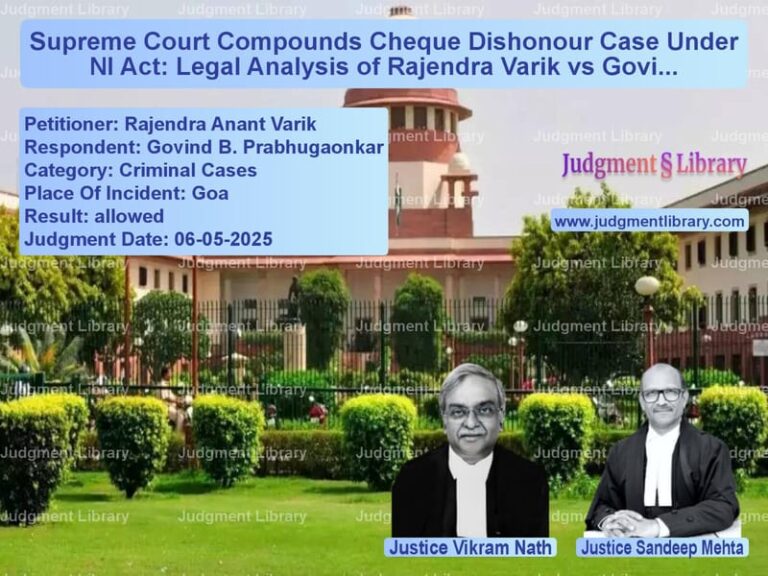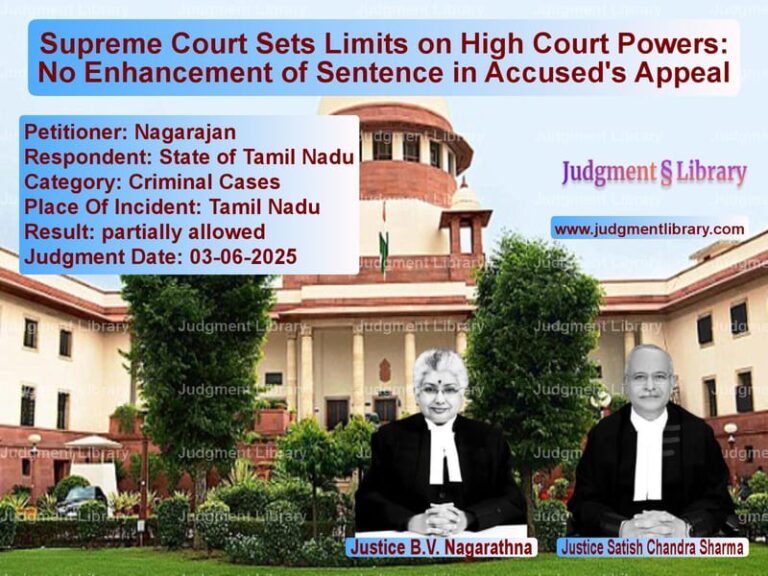Supreme Court Rules on Income Tax Deductions for Power Generation Companies
The Supreme Court of India has delivered a significant judgment in the case of Commissioner of Income Tax vs. Jindal Steel & Power Limited, dealing with the proper method for computing tax deductions under Section 80IA of the Income Tax Act, 1961. The ruling clarifies how companies engaged in power generation should determine profits and market value for the purpose of tax exemptions.
Background of the Case
The dispute arose when Jindal Steel & Power Limited (hereinafter referred to as “the Assessee”) claimed deductions under Section 80IA for profits generated by its captive power plants. The Income Tax Department (hereinafter “the Revenue”) challenged the computation of profits, arguing that the Assessee was inflating profits by setting an artificially high rate for electricity supplied to its own industrial units.
The Assessing Officer observed that the Assessee had:
- Sold power to its captive units at Rs.3.72 per unit.
- Supplied surplus power to the State Electricity Board at Rs.2.32 per unit.
The Revenue contended that the lower rate (Rs.2.32 per unit) should be considered the market value for computing profits and deductions under Section 80IA. The case was escalated through various appellate forums before reaching the Supreme Court.
Legal Issues Raised
- What constitutes the ‘market value’ of power for the purpose of tax deduction under Section 80IA?
- Can the rate charged to industrial consumers be considered over the rate at which surplus power is supplied to the State Electricity Board?
- Did the Assessee artificially inflate profits to maximize deductions?
- How should depreciation on power plant assets be calculated?
Arguments of the Petitioner (Revenue)
The Revenue contended:
- The Assessee inflated profits by setting a higher internal sale price for power supplied to its own units.
- Since surplus power was sold to the State Electricity Board at Rs.2.32 per unit, this rate should be the benchmark.
- Allowing a higher rate would lead to excessive tax benefits, creating an unfair tax advantage.
- The depreciation of power plant assets should be calculated using the Written Down Value (WDV) method rather than the Straight-Line Method.
Arguments of the Respondent (Jindal Steel & Power Ltd.)
The Assessee countered:
- The rate of Rs.3.72 per unit was justified as it reflected the rate charged by the State Electricity Board to industrial consumers.
- The Rs.2.32 per unit was an artificially lower price imposed due to regulatory constraints, not the actual market value.
- The market value should be based on the price paid by industrial consumers, as captive power plants exist to supply power to industrial units.
- The Assessee had the statutory right to choose the depreciation method, as allowed under the Income Tax Act.
Supreme Court’s Observations
1. Determination of Market Value Under Section 80IA
The Court ruled that the appropriate benchmark for determining the market value of electricity is the rate charged by the State Electricity Board to industrial consumers, not the rate at which surplus power is supplied to the grid.
“Market value should be based on the price at which power is normally supplied to similar consumers under comparable conditions.”
Since industrial consumers in the open market paid Rs.3.72 per unit, this was the correct benchmark.
2. No Artificial Inflation of Profits
The Court rejected the Revenue’s argument that the Assessee manipulated rates to inflate profits:
“There is no evidence that the Assessee artificially increased profits. The price charged aligns with the market rate and reflects actual commercial transactions.”
3. Choice of Depreciation Method
The Court upheld the Assessee’s right to use the Straight-Line Method (SLM) for depreciation:
“The Income Tax Act allows assessees to choose their method of depreciation, provided it is applied consistently and in accordance with statutory provisions.”
4. Carbon Credit Treatment
The Court addressed the issue of tax treatment of carbon credits but deferred ruling on whether such credits should be considered capital or revenue receipts. This question was left open for future litigation.
Final Judgment
The Supreme Court ruled:
- The market value for Section 80IA deductions should be based on the industrial consumer rate (Rs.3.72 per unit).
- The appeal by the Revenue was dismissed, and the decision of the Income Tax Appellate Tribunal (ITAT) in favor of the Assessee was upheld.
- The Assessee was entitled to depreciation as per the Straight-Line Method.
- The issue of carbon credit tax treatment was left for future cases.
Key Takeaways
1. Market Value Definition Strengthened
The ruling clarifies that for captive power plants, the market value should be based on the price paid by industrial consumers.
2. No Scope for Revenue to Dispute Internal Pricing
The judgment prevents tax authorities from arbitrarily questioning internal sale rates if they align with market prices.
3. Flexibility in Depreciation Calculation
Companies have the right to choose between SLM and WDV for depreciation, provided it complies with statutory provisions.
4. Carbon Credit Taxation Unresolved
The Court left open the question of whether carbon credits should be treated as capital or revenue receipts, signaling future judicial clarification.
Conclusion
This Supreme Court decision is a major victory for power-generating companies seeking tax deductions under Section 80IA. It affirms that market value should be determined based on real-world pricing practices rather than arbitrary regulatory prices. This ruling will serve as a precedent in tax disputes involving internal transfer pricing for captive units.
Petitioner Name: Commissioner of Income Tax.Respondent Name: Jindal Steel & Power Limited.Judgment By: Justice B. V. Nagarathna, Justice Ujjal Bhuyan.Place Of Incident: India.Judgment Date: 05-12-2023.
Don’t miss out on the full details! Download the complete judgment in PDF format below and gain valuable insights instantly!
Download Judgment: commissioner-of-inco-vs-jindal-steel-&-power-supreme-court-of-india-judgment-dated-05-12-2023.pdf
Directly Download Judgment: Directly download this Judgment
See all petitions in Income Tax Disputes
See all petitions in GST Law
See all petitions in Tax Evasion Cases
See all petitions in Banking Regulations
See all petitions in Tax Refund Disputes
See all petitions in Judgment by B.V. Nagarathna
See all petitions in Judgment by Ujjal Bhuyan
See all petitions in dismissed
See all petitions in supreme court of India judgments December 2023
See all petitions in 2023 judgments
See all posts in Taxation and Financial Cases Category
See all allowed petitions in Taxation and Financial Cases Category
See all Dismissed petitions in Taxation and Financial Cases Category
See all partially allowed petitions in Taxation and Financial Cases Category







